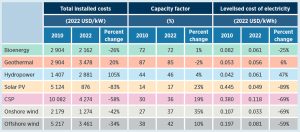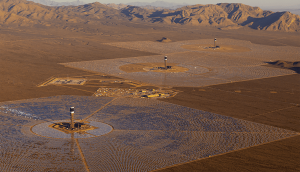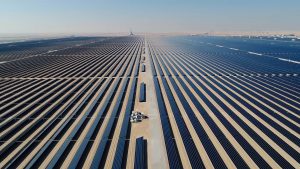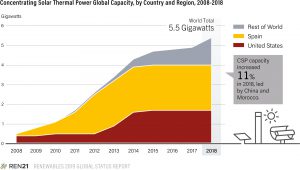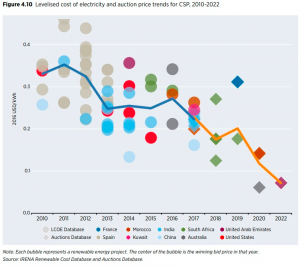Concentrated solar power (CSP) saw its global weighted‑average LCOE fall from 591% higher than the cheapest fossil fuel option in 2010 to 71% higher in 2022. Concentrated solar power (CSP) deployment remains disappointing, with less than 0.1 GW added in 2022 and global cumulative capacity standing at 6.5 GW at the end of 2022. For …
Concentrated solar power has one huge advantage: the energy can be converted into electricity even when the Sun isn’t shining
James McKenzie believes that “concentrator solar power” could be the answer to our environmental woes. The Ivanpah Solar Power Facility in Nevada uses thousands of mirrors to focus sunlight onto a tank of water at the top of a tower, with the resulting steam being used to drive turbines. (Courtesy: BrightSource Energy) Modern solar cells …
The cost of Concentrated Solar Power declined by 16%
The cost of renewables, meanwhile, continued to fall even in 2020, despite Covid-linked disruption. The cost of electricity from utility-scale solar PV declined by 7% year-on-year, while offshore wind fell by 9%, onshore wind 13% and concentrating solar power by 16%. Solar PV and onshore wind power are now consistently cheaper than fossil fuel-powered plants, …
Continue reading “The cost of Concentrated Solar Power declined by 16%”
Irena: Concentrated Solar Power costs have fallen by 47%
Renewable electricity costs have fallen sharply over the past decade, driven by improving technologies, economies of scale, increasingly competitive supply chains and growing developer experience. Since 2010, utility-scale solar PV power has shown the sharpest cost decline at 82%, followed by concentrating solar power (CSP) at 47%, onshore wind at 39% and offshore wind at …
Continue reading “Irena: Concentrated Solar Power costs have fallen by 47%”
Concentrated Solar Power costs are expected to fall by 79% by 2022
Concentrating Solar Power costs have already plummeted by 47% compared to 2010. It is likely that costs will continue their downward trajectory thanks to economies of scale, deployment in locations with better solar resources and lower costs of capital, according to a study by the International Renewable Energy Agency (IRENA). The International Renewable Energy Agency …
Continue reading “Concentrated Solar Power costs are expected to fall by 79% by 2022”
Concentrated Solar Power Quietly Makes a Comeback
CSP’s costs are dropping as the market gains steam in the Middle East and China. Can this once-promising technology regain its mojo? Concentrated solar power (CSP), a renewable energy technology that has more or less dropped off the radar in the U.S., is quietly becoming competitive elsewhere. A recent analysis of power generation costs from the …
Continue reading “Concentrated Solar Power Quietly Makes a Comeback”
Irena: Concentrated Solar Power Costs Fell 46% From 2010–2018
The International Renewable Energy Agency (IRENA) has reported that energy generation and installation costs of concentrated solar power (CSP) projects fell sharply in 2018, down more than 40% from 2010. IRENA analyzed multiple financial and technical parameters related to concentrated solar power projects in its latest report Renewable Power Generation Costs in 2018. The agency …
Continue reading “Irena: Concentrated Solar Power Costs Fell 46% From 2010–2018”
The average cost of electricity declined 26% year-on-year for concentrated solar power (CSP)
Renewable energy has become an increasingly competitive way to meet new power generation needs. This comprehensive cost study from the International Renewable Energy Agency (IRENA) highlights the latest trends for each of the main renewable power technologies. Released ahead of high-profile United Nations energy and climate discussions, Renewable Power Generation Costs in 2018 draws on the …
IRENA: Middle East Voncentrated Solar Power cost reductions require creative financing
Developers of large-scale renewable energy projects in the Gulf Cooperation Council (GCC) must use innovative financing structures to minimize costs amid a growing demand for funding, the International Renewable Energy Agency (IRENA) said in a report on the Middle East region, published January 15. The GCC members are Saudi Arabia, Kuwait, the United Arab Emirates, …
Renewable Energy the Most Competitive Source of New Power Generation in GCC
Under current plans, the region will install 7 gigawatts (GW) of new power generation capacity from renewable sources by the early 2020s. Renewable energy is the most competitive form of power generation in Gulf Cooperation Council (GCC) countries, according to a new report published today by the International Renewable Energy Agency (IRENA). Abundant resources, together …
Continue reading “Renewable Energy the Most Competitive Source of New Power Generation in GCC”


